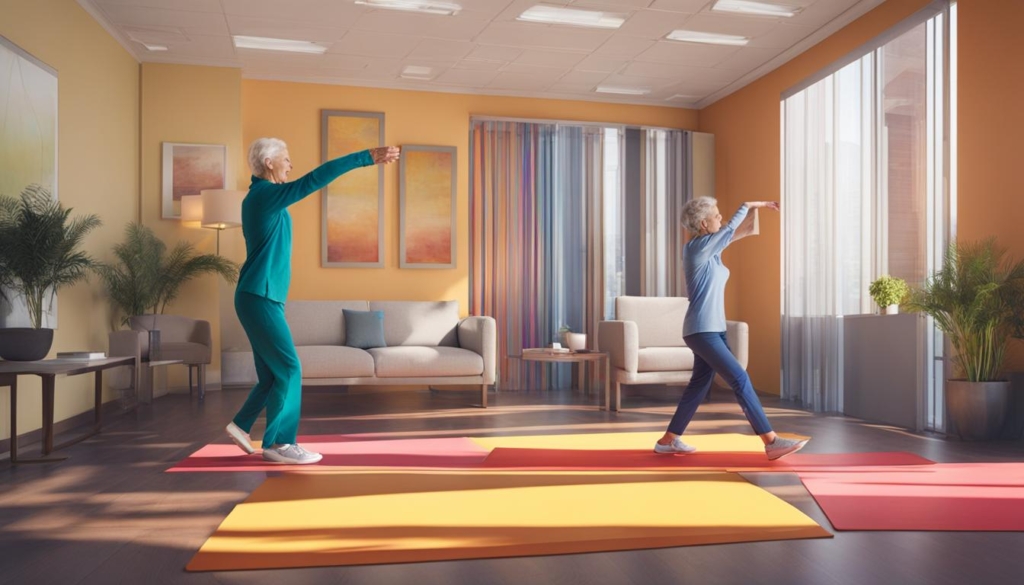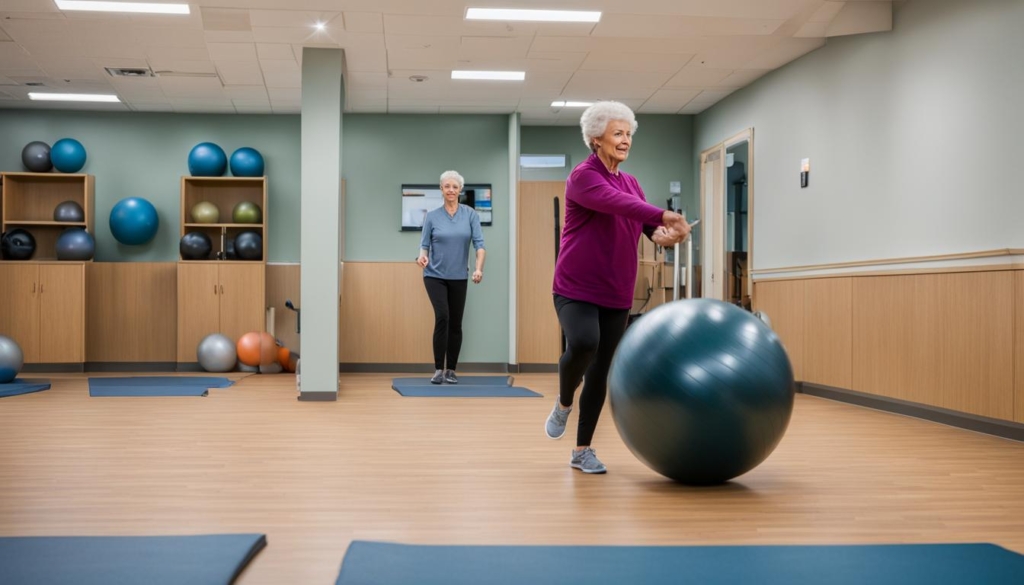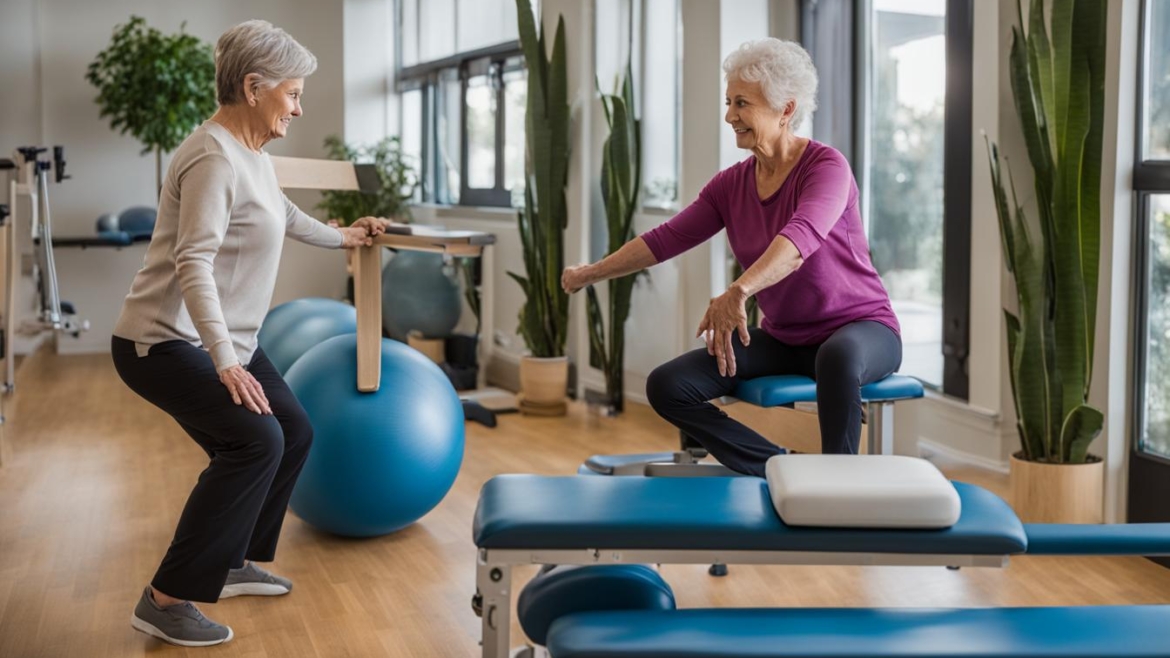The Path to Independence: Physical Therapy Techniques for Parkinson’s Patients
We stand at the forefront of a transformative journey, where the power of physical therapy for Parkinson’s disease shines as a beacon of hope. Our collective expertise and dedication are channeled into pioneering Parkinson’s disease treatment that embodies not just the pursuit of wellness, but the very essence of reclaiming autonomy. At the heart of Parkinson’s therapy lie the stories of those who navigate this path with unwavering determination, inspiring us to push the boundaries of what’s possible in mobility enhancement.
Together, we are invested in a mission that transcends the conventional—it’s about facilitating journeys marked by incremental victories and profound personal growth. Join us as we illuminate the techniques that empower individuals living with Parkinson’s disease—techniques that transform every subtle movement into a milestone and every stride into a testament of independence regained.
Key Takeaways
- Exploration of physical therapy as a cornerstone for improving mobility in Parkinson’s patients.
- Personal testimonies that underscore the pivotal role of Parkinson’s therapy in enhancing independence.
- An introduction to tailor-made Parkinson’s disease treatment strategies for diverse needs.
- A testament to the resolve and progress embodied by the Parkinson’s community.
- A prelude to the empowering and innovative approaches in physical therapy for Parkinson’s disease.
Understanding Parkinson’s Disease and Its Impact on Mobility
As we continue our discussion, let us explore the intricate relationship between Parkinson’s disease and the challenges it poses for mobility and movement. Parkinson’s disease is not only a neurological condition but a journey that individuals embark on, often requiring support and resilience. Understanding its symptoms and how they translate into everyday obstacles is crucial for developing effective Parkinson’s disease management strategies and therapies.
Defining Parkinson’s Disease and Its Symptoms
Parkinson’s disease is characterized by the progressive loss of dopaminergic neurons in the brain, particularly within the substantia nigra. This leads to an array of motor and non-motor Parkinson’s disease symptoms that extend beyond the anticipated tremors. Patients may experience rigidity in the limbs, bradykinesia which is a slowness of movement, and postural instability. Non-motor symptoms can include mood disorders, sleep disturbances, and cognitive impairment. Together, these manifestations form a profile that requires thoughtful Parkinson’s disease management.
How Parkinson’s Disease Affects Movement
With the presence of symptoms such as rigidity and bradykinesia, individuals with Parkinson’s disease find their mobility significantly impacted. These symptoms hinder basic daily activities that many of us take for granted, such as dressing, eating, and walking. The tremors, a hallmark of the disease, add an additional layer of complexity to fine motor skills, complicating tasks like writing or buttoning a shirt. Understanding these symptoms’ impact on movement helps inform Parkinson’s disease therapies, focusing on both improving the quality of life and preserving independence.
| Symptom | Impact on Mobility | Therapies and Management Techniques |
|---|---|---|
| Tremors | Difficulty with fine motor skills and coordination | Targeted exercises, medication, supportive devices |
| Rigidity | Limited range of motion and discomfort during movement | Physical therapy, stretching routines, muscle relaxants |
| Bradykinesia | Slowed motions, challenges with walking and initiating movement | Occupational therapy, exercise programs, dopaminergic therapy |
| Postural Instability | Risk of falls and difficulty maintaining upright posture | Balance exercises, posture training, environmental modifications |
Personalizing Physical Therapy for Parkinson’s Disease


At the heart of Parkinson’s disease rehabilitation lies a commitment to tailoring exercises and therapies to meet the distinct needs of each individual. We understand that each journey with Parkinson’s is unique, and so must be the approach to enhancing mobility and quality of life.
As facilitators of healing and advocates for empowerment, we explore a variety of Parkinson’s disease exercises for mobility, always aligning our strategies with the personal challenges and strengths of our patients. Every therapy plan is a carefully crafted map, charting a course through the complexities of Parkinson’s with the goal of achieving the greatest possible independence.
Our team works closely with patients, considering:
- Their current physical capabilities and limitations
- The stage and progression of Parkinson’s disease
- Previous experiences with physical therapy and exercise
- Personal preferences and lifestyle considerations
We integrate these insights to shape a holistic and dynamic programme of Parkinson’s disease rehabilitation. It’s not just about the exercises; it’s about reconstructing a sense of agency for our patients—helping them regain control over their bodies to the highest degree possible.
Motivation is key, and personalized therapy plans are far more than a clinical necessity; they’re a beacon of hope, a testament to the belief that progress is always within reach.
In our pursuit of innovation and efficacy, we often find that the best ideas come directly from our patients. Their feedback and experiences are invaluable in refining the programming to offer exercises that are not only beneficial but also engaging and enjoyable.
Witnessing the tangible improvements in mobility, the smiles of triumph after a successful therapy session, fuels our dedication to this important work. Together, we forge a path through the hurdles of Parkinson’s, paving it with strength, courage, and unwavering support, one personalized therapy session at a time.
Physical Therapy for Parkinson’s Disease: Establishing Goals
Within the realm of Parkinson’s disease management, a collaborative effort between patients and therapists is vital. Together, we strive to craft personalized objectives that not only foster independence but also infuse individuals with the confidence needed to overcome their mobility challenges. Setting these targets becomes the cornerstone of a successful Parkinson’s disease exercise regimen.
Setting Achievable Targets for Independence
At the outset of therapy, we counsel our patients to set realistic and achievable goals – an approach that translates aspirations into tangible results. Drawing upon our collective expertise and understanding of Parkinson’s disease, we identify exercises that resonate with each person’s capabilities and lifestyle. This patient-centered planning facilitates a deeper sense of autonomy and paves the way for incremental victories.
Measuring Progress Towards Physical Autonomy
Charting the path of progress is as necessary as the therapy itself. We introduce systems to monitor improvements, ensuring that every small step forward is recognized and celebrated. These measures not only track the effectiveness of Parkinson’s disease management plans but also reinforce the commitment of our patients as they witness their evolution towards physical autonomy.
| Therapy Milestone | Treatment Week | Progress Indicators |
|---|---|---|
| Enhanced Balance | Week 4 | Increased stand time, reduced assistance needs |
| Fine Motor Skills | Week 8 | Improved writing, eating without spillage |
| Walking and Gait | Week 12 | Lengthened stride, smoother transitions |
| Overall Mobility | Ongoing | Consistent activity levels, self-reporting ease in daily tasks |
Essential Physical Therapy Exercises for Parkinson’s Patients


With determination and the right approach, Parkinson’s disease exercises can play a crucial role in managing symptoms and improving quality of life. As we focus on Parkinson’s disease treatment, let’s explore exercises specifically tailored to build balance, coordination, and strength—core components that serve as the foundation of stability and daily function.
Exercises to Improve Balance and Coordination
Balancing exercises are imperative for Parkinson’s patients. They aid in enhancing proprioception, which is critical for knowing the position of one’s body in space. This awareness is essential for preventing falls and fostering confidence in movement. Improve your balance and coordination with these activities:
- Tai Chi: Slow, deliberate movements with deep breathing to cultivate stability
- One-Leg Stands: Practicing standing on one leg to stimulate balance receptors
- Heel-To-Toe Walk: Encouraging a focused effort on coordination while moving
Pair these exercises with routine activities like walking or climbing stairs to integrate balance practice into daily life seamlessly.
Strength Building Routines for Stability
Targeted strength training is vital in building the muscles that keep Parkinson’s patients stable. By focusing on specific muscle groups, we can fortify the body’s framework, enhancing stability and control. Below are strength exercises integral to Parkinson’s disease treatment:
| Exercise | Target Muscle Group | Benefit |
|---|---|---|
| Squats | Legs, Glutes | Builds lower body strength for improved support |
| Wall Push-Ups | Chest, Shoulders, Arms | Enhances upper body stability |
| Seated Leg Extensions | Quadriceps | Bolsters leg stability for everyday tasks |
Incorporate these routines into your weekly schedule, gradually increasing intensity as strength builds, to overcome the challenges posed by Parkinson’s disease and reclaim control over your movements.
Innovative Parkinson’s Disease Therapies and Techniques
As we delve into the realm of Parkinson’s disease therapies, we’re met with a landscape brimming with potential. Pioneering research paves the way for groundbreaking techniques that promise to revolutionize the way we approach Parkinson’s rehabilitation. In our arsenal, we not only have traditional methods, but also an array of cutting-edge therapies to interweave with tried and true Parkinson’s disease exercises.
Imagine a future where managing Parkinson’s symptoms is intricately tailored to each individual’s DNA, or where virtual reality transports patients to a space where therapy transcends the confines of physical limitations. The promising horizon of therapeutics in this field is not a distant dream—it’s here and now, transforming lives with each scientific stride.
Below, we present an overview of the innovative therapies that are not just on the precipice but are actively being integrated into treatment plans across the globe. We combine technology, science, and compassionate care to craft an approach that’s as dynamic as the individuals it serves.
| Therapy | Description | Benefits |
|---|---|---|
| Neuromodulation | Utilizes electrical or magnetic fields to stimulate brain neurons | Improves motor function and reduces tremors |
| Gene Therapy | Targets specific genes within the body to manage disease progression | Potentially slows or halts disease development |
| Virtual Reality Training | Leverages VR environments for gait and balance exercises | Enhances motor learning and provides engaging exercise scenarios |
| Telemedicine | Conducts remote sessions for easier access to therapists | Extends care to those with mobility or transportation limits |
These innovative approaches offer hope and inspire confidence in our shared fight against the challenges of Parkinson’s. As we continue to research and develop even more advanced options, the promise is clear: a future where Parkinson’s disease therapies and exercises empower and redefine the landscape of care.
Collaborative Care: Working Together to Manage Parkinson’s Disease


At the heart of effective Parkinson’s disease management lies a synergistic approach that involves not just the patients themselves but those who surround them—both in their personal and medical spheres. Achieving the best possible outcomes in Parkinson’s therapy requires a tapestry of support, where every thread contributes to the strength of the whole.
How Family Members Can Support Physical Therapy Routines
A robust home support system plays a critical role in reinforcing physical therapy routines. Loved ones are often in the best position to encourage exercise, create a positive atmosphere, and ensure a safe environment conducive to ongoing rehabilitation. Let us explore the myriad ways family members can be an integral part of a Parkinson’s patient’s therapeutic journey:
- Motivating patients to adhere to their exercise routines;
- Assisting with movements and exercises as directed by physical therapists;
- Offering emotional support to overcome the frustrations and challenges associated with the disease;
- Facilitating a home layout that minimizes fall risks and promotes ease of movement.
With every step, every stretch, every strengthening exercise, family members are there, making each manageable, yet vital, contribution towards progress and autonomy.
Integrating Multidisciplinary Teams in Parkinson’s Care
Moreover, the cornerstone of any comprehensive Parkinson’s therapy program is the involvement of multidisciplinary teams that converge their expertise for the betterment of the patient’s health. Neurologists, physical therapists, occupational therapists, speech-language therapists, and many others form a united front to provide holistic care.
In our pursuit to enhance the quality of life for those with Parkinson’s, here’s how multidisciplinary teams make an indelible impact:
- Combining diverse proficiencies to tackle various symptoms of Parkinson’s disease;
- Creating individualized care plans that account for the distinctive needs of each patient;
- Encouraging cross-collaboration among specialists for a more thorough understanding of the disease progression and patient response;
- Streamlining communication between all parties involved to ensure a consistent and efficient treatment protocol.
By educating ourselves, supporting one another, and harnessing the combined knowledge of a talented healthcare cohort, we endeavor to rise above the challenges Parkinson’s disease brings into our lives.
Adapting Home Environments for Parkinson’s Disease Exercises
As champions of Parkinson’s disease exercises for mobility, we recognize the value of a safe and personalized home environment. By integrating Parkinson’s disease rehabilitation habits into the home setting, we can foster a sense of security and consistency, necessary for effective management of Parkinson’s disease symptoms. Let us delve into practical modifications that ensure your living space supports your journey to mobility and independence.
- Clear walkways to minimize tripping hazards and allow for unobstructed movement during exercises.
- Install grab bars in critical areas such as the bathroom and along hallways to offer support.
- Use non-slip mats in areas prone to wetness, providing stable footing while performing exercises.
- Incorporate adequate lighting to ensure visibility, especially in staircases and workout areas.
- Arrange furniture to create ample space for free movement and exercise routines.
To further aid in visualizing the optimal layout for a Parkinson’s-friendly exercise space, here’s a comparative table highlighting recommendations for different zones within your home:
| Home Zone | Safety Adaptations | Exercise-Friendly Features |
|---|---|---|
| Living Room | Secure rugs with double-sided tape | Open area for yoga mats or portable exercise gear |
| Kitchen | Lowered countertops for seated exercises | Slip-resistant flooring material |
| Bedroom | Bed rails for support when standing up | Space next to bed for morning stretch routines |
| Bathroom | Shower seat and handheld showerhead | Room for seated or standing balance exercises |
In summary, our homes can and should be sanctuaries where Parkinson’s disease exercises for mobility are not only possible but encouraged. With thoughtful adaptations and a commitment to regular Parkinson’s disease rehabilitation practices, those living with Parkinson’s can experience improved mobility and independence. Together, let us transform everyday living spaces into empowering havens for health and progress.
The Role of Assistive Devices in Parkinson’s Disease Rehabilitation
In striving to return autonomy to individuals with Parkinson’s, we look towards assistive devices as vital companions in the landscape of Parkinson’s disease treatment. Our collective encounter with Parkinson’s disease exercises and recovery has illuminated the transformative impact that these tools can have on a patient’s quest for independence. In this critical phase of rehabilitation, identifying and integrating the right assistive technologies paves the way for not just movement, but empowerment.
Selecting the Right Tools to Enhance Independent Movement
The selection of assistive devices for Parkinson’s is as nuanced as the condition itself. We advocate for a well-considered approach, one that encompasses an understanding of the individual’s unique challenges and capabilities. Key to this process is the tailored use of equipment, ranging from walkers and canes to more specialized devices such as laser-guided walkers that can aid in reducing the freezing of gait, a common symptom in Parkinson’s. Our insights aim to guide patients in navigating this diverse array of tools, pinpointing those that align with their personal rehabilitation goals.
Maintaining Safety and Comfort with Adaptive Equipment
For us, the effective incorporation of adaptive equipment is not solely about movement—it’s also about securing safety and comfort. The use of the right aids can drastically minimize the risk of falls and provide much-needed stability, which is crucial for conducting daily Parkinson’s disease exercises safely. Our discussions cover not only the ergonomic benefits of such devices but also the psychological reassurance they offer. By ensuring convenience and security, assistive devices elevate the quality of life, making each day a step forward in the graceful dance of Parkinson’s disease management.
FAQ
What are the primary goals of physical therapy for Parkinson’s Disease?
The primary goals of physical therapy for Parkinson’s Disease include enhancing mobility, improving balance and coordination, increasing muscle strength for stability, and fostering overall independence. By setting achievable targets, we aim to empower individuals to reclaim a sense of autonomy and improve their quality of life.
How can physical therapy aid in the management of Parkinson’s Disease symptoms?
Physical therapy plays a crucial role in managing Parkinson’s Disease symptoms such as tremors, rigidity, and bradykinesia. Tailored exercises can help mitigate these symptoms, provide relief, and enhance functional movement patterns, making daily activities more manageable.
Can family members participate in the management of Parkinson’s Disease?
Absolutely! Family members are encouraged to support their loved ones with Parkinson’s Disease by being involved in physical therapy routines, reinforcing exercises at home, and offering emotional support. A collaborative approach helps build a resilient environment for managing the condition.
What are some key physical therapy exercises recommended for Parkinson’s patients?
Key physical therapy exercises for Parkinson’s patients involve routines to enhance balance, such as standing on one foot, tandem walking, and gentle weight shifting. Strength-building exercises include leg lifts, seated leg presses, and resistance band workouts. These routines aid in building the necessary muscle groups to improve stability and mobility.
How important is it to personalize a physical therapy plan for Parkinson’s Disease?
Personalization is paramount in physical therapy for Parkinson’s Disease. Each individual’s symptoms and progression are unique, requiring tailored plans that address their specific challenges and goals. Personalizing therapy ensures more effective and targeted treatment, thereby enhancing motivation and outcomes.
What is the role of multidisciplinary teams in Parkinson’s Disease management?
Multidisciplinary teams play a vital role in Parkinson’s Disease management by offering a diverse range of expert insights and therapies. Neurologists, physical therapists, occupational therapists, speech therapists, and mental health professionals collaborate to provide comprehensive care that addresses all aspects of the patient’s well-being.
How can we track progress in physical therapy for Parkinson’s Disease?
Progress is tracked by setting clear, measurable goals and using assessment tools to monitor improvements in mobility, strength, and coordination. Patient feedback, clinical observations, and standardized tests help in assessing advancements, thereby allowing for adjustments in therapy to optimize results.
What assistive devices are useful in Parkinson’s Disease rehabilitation?
Assistive devices that are beneficial in Parkinson’s rehabilitation include walkers, canes, specially designed footwear to improve gait, and grab bars to ensure safety in the home. Adaptive utensils and writing aids also help in maintaining independence in daily activities. Selecting the right tools is crucial to enhancing independent movement and ensuring safety and comfort.
How can the home environment be adapted to assist with Parkinson’s Disease exercises?
Adapting the home environment involves creating safe and clutter-free spaces, securing rugs to prevent slips, and installing grab bars in critical areas such as the bathroom. Adequate lighting, simplified layouts, and the placement of furniture to aid in walking are also essential modifications that encourage the continuous practice of Parkinson’s Disease exercises for mobility.
What are the latest innovations in therapies for Parkinson’s Disease?
The latest innovations in Parkinson’s Disease therapies include techniques like neuroplasticity exercises, virtual reality training, and non-invasive brain stimulation. These advanced strategies are designed to enhance efficacy and can be integrated alongside traditional physical therapy exercises to offer comprehensive treatment options.

